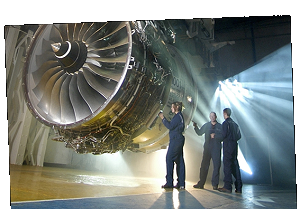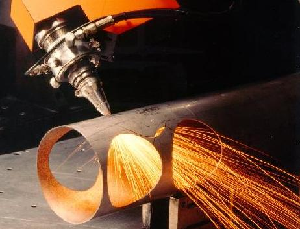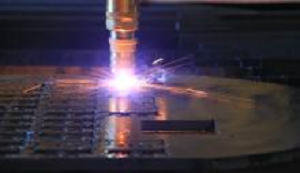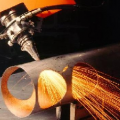
Most aircraft engines are primarily constructed of metal components, though there are now plastic composite materials that are being used for certain parts. For parts that require great strength, but light weight such as structural components, compressor sections and engine frames, various aluminum and titanium alloys are used.
For parts that need high heat and temperature resistance, chromium, nickel and cobalt alloys are favored. Steel is used in a variety of locations on aircraft.
In reality, almost every common metalworking and machining operation is involved in the manufacturing of an aircraft engine. The processes used include hot forging for airfoils and compressor disks, casting of all structural components and engine frames, grinding, turning, drilling, broaching, milling, shearing, sawing, threading, welding, brazing and thermal or plasma spraying.
The reason almost all machining tools are involved in aircraft manufacturing is that the materials used all have very high strength and hardness. There is also the need for complex shaping and precision tolerances that can only be achieved with computer controlled machining.
Apart from the common types of machining processes, the aerospace industry also uses some unique metalworking processes like chemical and electrochemical milling, laser drilling, electron beam welding and electro-discharge machining.
Chemical and Electrochemical Milling
These two processes are used when there is a need to remove metal from large surfaces in a way that either retains or creates a contour. Depending on the alloy, the parts are placed in acid, caustic or electrolyte bath that is high concentrated and controlled. The metal is removed by the chemical or electrochemical action.
These processes are most commonly used in the aerospace industry to work with airfoils after they have been forged to reduce wall thicknesses down to precise specifications while maintaining the contour of the airfoil.
Electro Discharge Machining and Laser Drilling
 These processes are utilized to make small diameter holes or very intricate contours in hard metals. Combustor and turbine components need these types of holes to ensure proper cooling.
These processes are utilized to make small diameter holes or very intricate contours in hard metals. Combustor and turbine components need these types of holes to ensure proper cooling.
Metal is removed by the high frequency thermo-mechanical action of electro-spark discharges. The process is done in a dielectric mineral oil bath. The electrode works as the reverse image of the desired cut.
Electron-Beam Welding
Electron-beam welding joins parts where a deep weld penetration is required in difficult to access areas. A focused, accelerated beam of electrons in a vacuum chamber are used to generate the weld. The heat for the weld is generated by the kinetic energy of the electrons when they strike the work piece.
CNC Machining
CNC machining uses computers to control various machine tools. Some of the tools that can be controlled with computers include lathes, mills, routers and grinders. It is the computer’s software and control console that sets apart CNC machines.
Machine tools function by numerical controls. Each machine is customized to the precise measurements for the specific object being manufactured. The machine is programmed using a machining language that controls all activities including the feed rate, coordination, location and speeds. CNC machines can control the exact positioning and speed, and can be used with both metal and plastic parts.
The benefit of CNC machining in precision industries like aerospace and automotive manufacturing is that the process is much more precise than manual machining and it can be precisely repeated over and over again, making it especially cost effective for high volume manufacturing jobs. The other benefit of CNC machining is that it allows the production of very complex shapes that would be impossible with manual machining.
Tolerances
 CNC machining is critical to the aerospace industry because of the extremely tight tolerances required. Manual machining cannot ensure that these tolerances can even be met, let alone met consistently.
CNC machining is critical to the aerospace industry because of the extremely tight tolerances required. Manual machining cannot ensure that these tolerances can even be met, let alone met consistently.
The ability to program precise measurements and reproduce them in volume is essential to keeping down costs and meeting safety requirements, as well as manufacturing requirements for these extremely small allowable tolerances.
This is one of the key benefits of computer controlled machining. The direction for CNC machining is to partner the machines with extremely sophisticated measurement systems to ensure tolerances are met.
Productivity
CNC machining has evolved over time and reached new levels of versatility with respect to the tools that they utilize. Machines can be assigned different tasks and use different tools so that they provide the aerospace industry with high levels of productivity. Both tools and networks can be switched without affecting the speed of production.
It is also possible for one machine to do more than one task simultaneously. This outperforms the capacity of any human. Another productivity benefit with CNC machining is that when one machine tool breaks, it can easily be taken off the grid, preventing it from affecting the whole production line. The tool can be replaced or repaired right on the production floor.
SUMMARY
The aerospace industry faces many challenges in the production of their products, be it an airplane, or military equipment. With complex three-dimensional shapes, high volumes and tight tolerances, the ability to mass produce parts cannot be handled manually. The materials used in aerospace manufacturing are especially durable and strong.
For all of these reasons, CNC machining plays an important role because computer controlled machines and robots provide a greater capacity to cut complex shapes and form strong, hard materials with consistency to meet the high tolerance demands of the industry.
